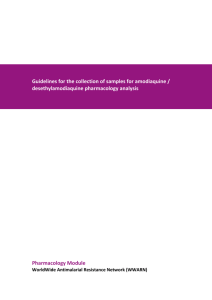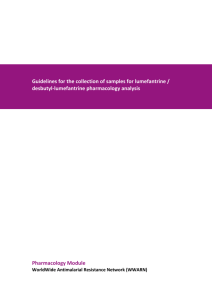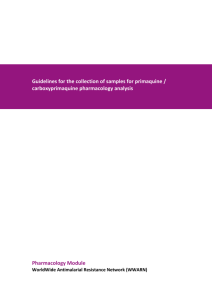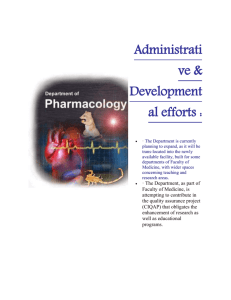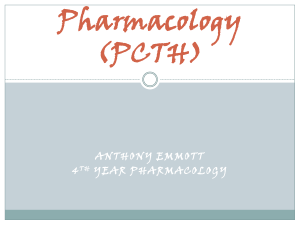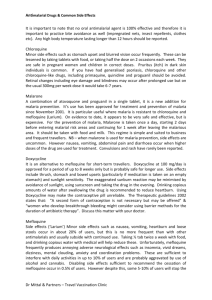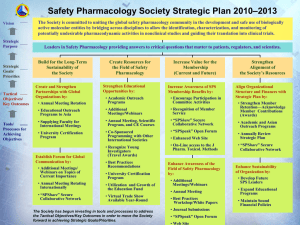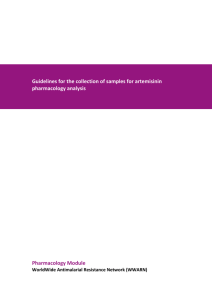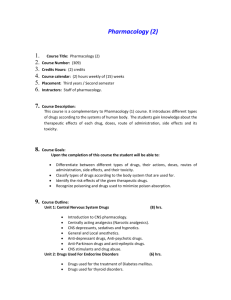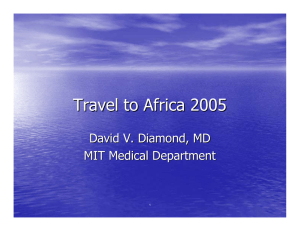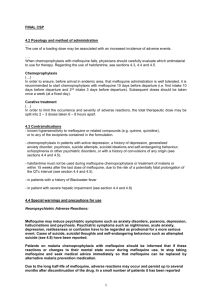docx - Worldwide Antimalarial Resistance Network
advertisement
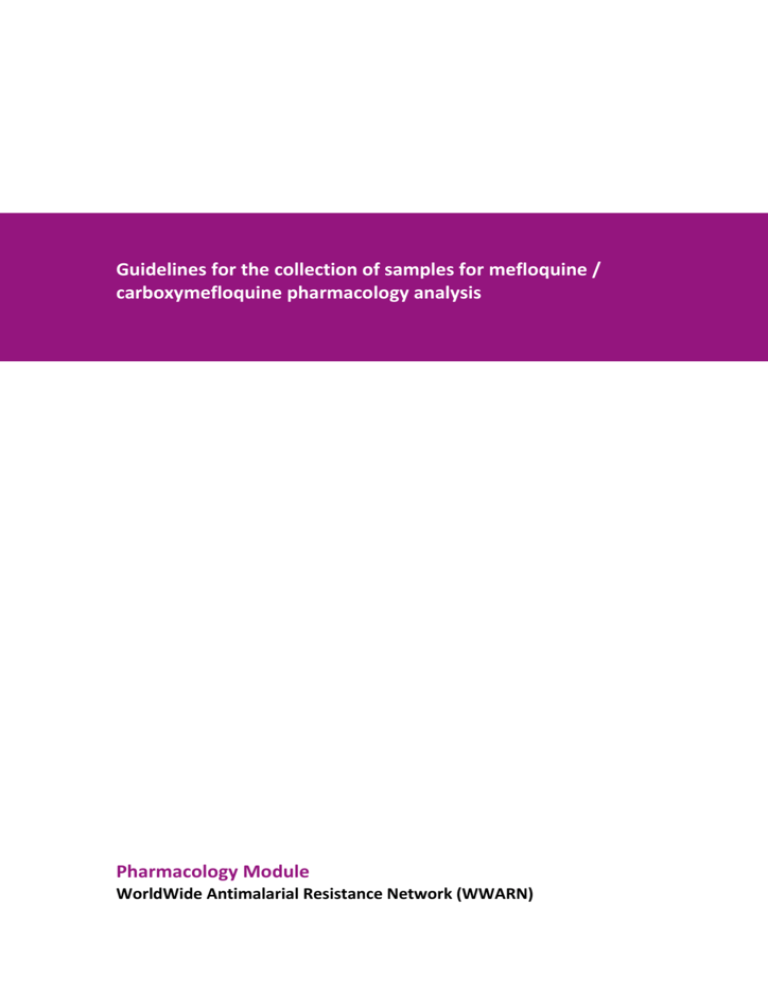
Guidelines for the collection of samples for mefloquine / carboxymefloquine pharmacology analysis Pharmacology Module WorldWide Antimalarial Resistance Network (WWARN) © 2011 WorldWide Antimalarial Resistance Network (WWARN) This publication may be quoted or reproduced without charge, provided the source is acknowledged. No use of this publication may be made for resale or other commercial purposes. All images remain the sole property of their source and may not be used without written permission of the source. Suggested citation: Pharmacology Module, WWARN. 2014. Guidelines for the collection of samples for mefloquine / carboxymefloquine pharmacology analysis v1.0. WWARN Procedure. Procedure ID: PHA07 This procedure was developed by: Pharmacology Module Version History Version number Revision(s) & reason for amendment Date of approval Issued by Approved by 1.0 New document 02/10/2015 Chris Lourens Joel Tarning For more information, contact: pharmacology@wwarn.org WorldWide Antimalarial Resistance Network (WWARN) www.wwarn.org WWARN Procedure: Guidelines for the collection of samples for Mefloquine pharmacology analysis Page 2/6 Contents 1. Purpose ......................................................................................................................4 2. Scope ..........................................................................................................................4 3. Abbreviations .............................................................................................................4 4. Duties and Responsibilities ........................................................................................4 5. Materials ....................................................................................................................4 6. Procedure ...................................................................................................................5 7. Sampling times ...........................................................................................................6 8. Stability ......................................................................................................................6 9. Reference ...................................................................................................................6 WWARN Procedure: Guidelines for the collection of samples for Mefloquine pharmacology analysis Page 3/6 1. Purpose The purpose of this document is to standardize the sample collection procedure during clinical studies of mefloquine / carboxymefloquine antimalarial drugs. This should be considered as a recommendation or as a definition of minimum requirements, created by the Worldwide Antimalarial Resistance Network (WWARN), aiming to achieve homogeneous quality in the pre-analytical phase of studies and to provide guidelines in the processes of collection, processing, preserving, storage, shipment and safe handling of samples from human origin. 2. Scope This document applies to those sites wishing to conduct clinical trials to assess the pharmacokinetics/pharmacodynamics of mefloquine / carboxymefloquine to support antimalarial drug investigation. NOTE: It is crucial to contact the analytical laboratory before commencement of the study to inquire about specific requirements of that particular laboratory. 3. Abbreviations WWARN QA/QC MQ MQm Worldwide Antimalarial Resistance Network Quality assurance / quality control Mefloquine Carboxymefloquine 4. Duties and Responsibilities The tasks to be completed for this procedure are listed below. Each of these must be assigned to an individual(s) who has been trained to perform these tasks and in the use of relevant health and safety precautions. Proper identification of patient and matching samples Collection of samples Processing of samples 5. Materials Samples for pharmacology analysis of MQ / MQm must be collected in plastic containers and transferred to polypropylene cryovials for transportation and storage. The tube should be at room temperature (18°- 25° C) prior to use. Use of plastic sampling and storage containers minimizes the risk for analyte adsorption and improves safety at the site. Choice of the paper used to collect dried blood spot samples must be made in consultation with the analytical laboratory. WWARN Procedure: Guidelines for the collection of samples for Mefloquine pharmacology analysis Page 4/6 Use either EDTA or heparin as an anticoagulant when whole blood or plasma is required as a matrix. (1) 6. Procedure Analysis of MQ / MQm may be done in whole blood, plasma, serum or dried blood spots per the validated bioanalytical method used for the analyses. Plasma and whole blood matrices are the most commonly used sampling procedures. Collect the required volume of whole blood following the local protocol for the collection of blood. Note: A catheter may be needed for dense sampling to reduce venipunctures. The minimum volume required may differ for individual laboratory methods. Please contact the laboratory first to obtain more information on specific needs. Mass spectrometry-based methods commonly require smaller volumes in the range of 100-500 microliters, and UV-based methods commonly require volumes in the range of 500-1000 microliters. Whole blood: Transfer whole blood directly into pre-labelled (Patient ID, date and clock time of collection) polypropylene cryovials with added EDTA or sodium or lithium heparin as anticoagulant. Store frozen (see section 8 below), do not thaw the sample after freezing. Plasma: Centrifuge EDTA or sodium or lithium heparin anticoagulated whole blood within 60 minutes of sampling at 1000 – 3000 x g for 7 – 15 minutes. Transfer the plasma into pre-labelled (Patient ID, date and clock time of collection) polypropylene cryovials. Store frozen (see section 8 below), do not thaw the sample after freezing. Serum: This matrix is obtained by collecting whole blood without an anticoagulant. Allow the blood to clot for at least 1 hour before centrifugation. After clot formation, centrifuge blood samples at 3000 x g for 15 minutes to obtain serum free of red blood cells. Remove serum by careful aspiration and transfer the serum into pre-labelled (Patient ID, date and clock time of collection) polypropylene cryovials. Store frozen (see section 8 below), do not thaw the sample after freezing. Dried blood spots: Apply whole blood directly to pre-labelled (Patient ID, date and clock time of collection) filter paper. If dried spot methodology is used, contact the laboratory to obtain more information on paper specifications, drying and storage conditions. WWARN Procedure: Guidelines for the collection of samples for Mefloquine pharmacology analysis Page 5/6 7. Sampling times Sampling times should be verified by a pharmacologist to ensure an informative clinical trial design. The sampling times vary depending on intended analysis technique (i.e. model-independent or model-based analysis) and also with the specific aim of the study (1). Suggested dense sampling times (1): Single dose: Split dose (0, 24 h): Three doses (0, 24, 48 h) Hour: 0, 1, 2, 3, 4, 6, 8, 10, 16, 24 Days: 5, 7, 14, 28, 42 Hour: 0, 1, 2, 3, 4, 6, 8, 32, 38, 48 Days: 5, 7, 14, 28, 42 Hour: 0, 1, 2, 3, 4, 6, 8, 32, 58, 96 Days: 5, 7, 14, 28, 42 8. Stability MQ / MQm are stable in plasma and serum at 4oC for up to 48 hours. Venous blood samples should not be stored for more than 1 hour at room temperature. It can also be stored at -20oC for up to three months. Long term storage at -80oC is usually sufficient for at least 1 year. 9. Reference 1.) Methods and techniques for assessing exposure to antimalarial drugs in clinical field studies. WHO. ISBN 978 92 4 150206 1, p43. WWARN Procedure: Guidelines for the collection of samples for Mefloquine pharmacology analysis Page 6/6
